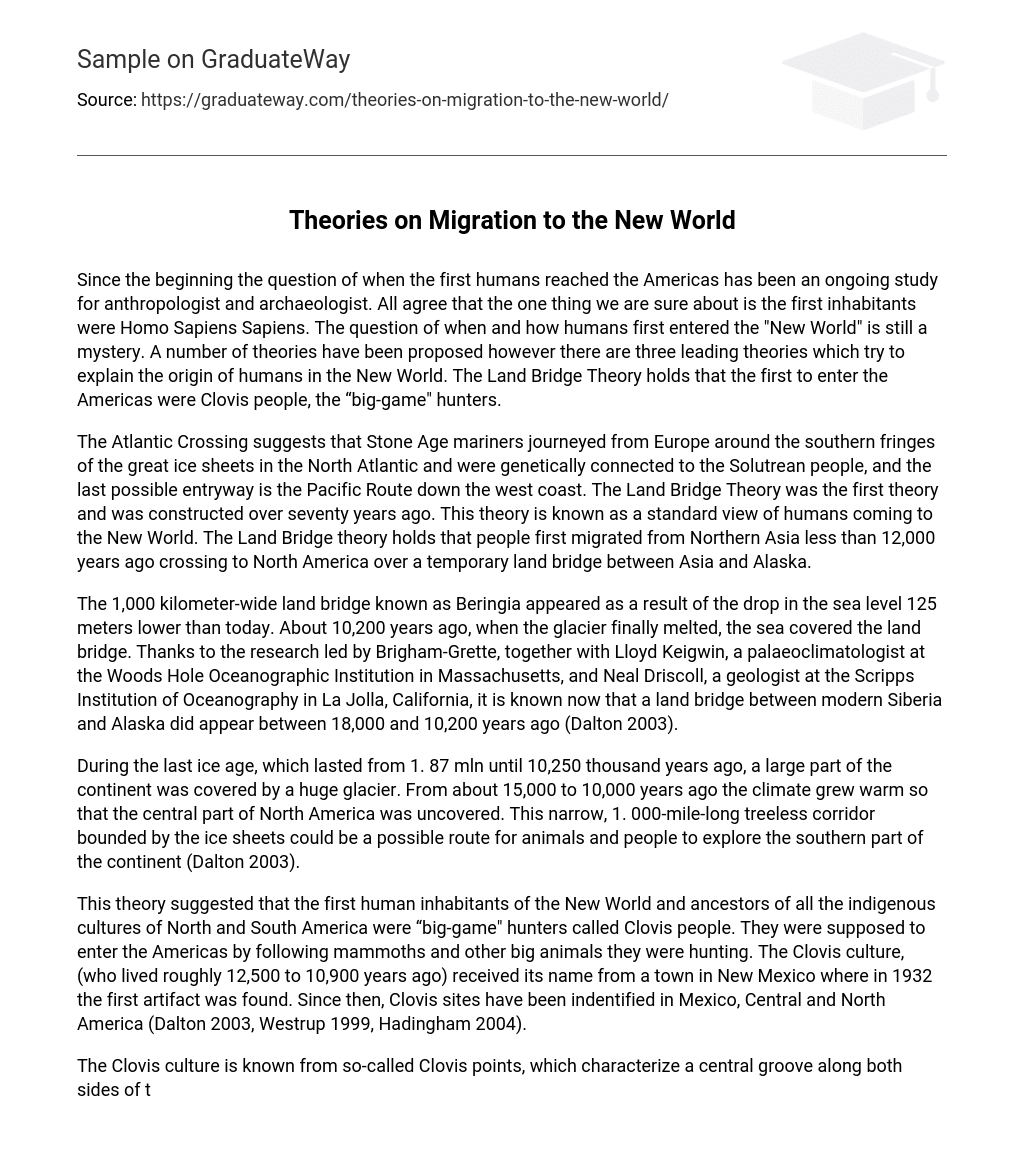Since the beginning the question of when the first humans reached the Americas has been an ongoing study for anthropologist and archaeologist. All agree that the one thing we are sure about is the first inhabitants were Homo Sapiens Sapiens. The question of when and how humans first entered the “New World” is still a mystery. A number of theories have been proposed however there are three leading theories which try to explain the origin of humans in the New World. The Land Bridge Theory holds that the first to enter the Americas were Clovis people, the “big-game” hunters.
The Atlantic Crossing suggests that Stone Age mariners journeyed from Europe around the southern fringes of the great ice sheets in the North Atlantic and were genetically connected to the Solutrean people, and the last possible entryway is the Pacific Route down the west coast. The Land Bridge Theory was the first theory and was constructed over seventy years ago. This theory is known as a standard view of humans coming to the New World. The Land Bridge theory holds that people first migrated from Northern Asia less than 12,000 years ago crossing to North America over a temporary land bridge between Asia and Alaska.
The 1,000 kilometer-wide land bridge known as Beringia appeared as a result of the drop in the sea level 125 meters lower than today. About 10,200 years ago, when the glacier finally melted, the sea covered the land bridge. Thanks to the research led by Brigham-Grette, together with Lloyd Keigwin, a palaeoclimatologist at the Woods Hole Oceanographic Institution in Massachusetts, and Neal Driscoll, a geologist at the Scripps Institution of Oceanography in La Jolla, California, it is known now that a land bridge between modern Siberia and Alaska did appear between 18,000 and 10,200 years ago (Dalton 2003).
During the last ice age, which lasted from 1. 87 mln until 10,250 thousand years ago, a large part of the continent was covered by a huge glacier. From about 15,000 to 10,000 years ago the climate grew warm so that the central part of North America was uncovered. This narrow, 1. 000-mile-long treeless corridor bounded by the ice sheets could be a possible route for animals and people to explore the southern part of the continent (Dalton 2003).
This theory suggested that the first human inhabitants of the New World and ancestors of all the indigenous cultures of North and South America were “big-game” hunters called Clovis people. They were supposed to enter the Americas by following mammoths and other big animals they were hunting. The Clovis culture, (who lived roughly 12,500 to 10,900 years ago) received its name from a town in New Mexico where in 1932 the first artifact was found. Since then, Clovis sites have been indentified in Mexico, Central and North America (Dalton 2003, Westrup 1999, Hadingham 2004).
The Clovis culture is known from so-called Clovis points, which characterize a central groove along both sides of the blade. It is generally accepted that Clovis people hunted mammoth, mastodons and bison’s as Clovis points are found mixed in with their remains. There is also a hypothesis suggesting that the Clovis people may have driven the mammoth to extinction via overhunting. The rarity of points and the absence of other artifacts or signs of settlement suggest that they were moving long distances.
It was probably because of their dependence on migrations of big mammals that they were dependent on (Hadingham 2004, Schwimmer 1998). The second idea of human migration to the New World suggests that the first colonizers traveled across the North Atlantic between Europe and America around the southern fringes of the great ice sheets. This view was proposed by Dennis Stanford, a Clovis expert at the Smithsonian Institution’s Department of Anthropology, and Bruce Bradley, a prehistoric stone tool specialist at Britain’s University of Exeter.
They suggested that the strong resemblance between Clovis points and weapons from ice age Europe proves the affinity between Clovis and Solutrean people, who lived in southwest France and northern Spain during the coldest spell of the ice age, from around 24,000 to 19,000 years ago (Hadingham 2004). Many archaeologists do not believe that people made a 3,000-mile journey about 17,000 years ago when the Atlantic would have been much colder and stormier than today as there is little evidence of seafaring technology in the Solutrean sites in Spain.
The pacific coast route view proposed by archaeologist Knut Fladmark from University of Simon Fraser in Vancouver presumes that early colonizers traveled along the frozen Bering land bridge and down the west coast of the Americas using small skin-covered boats. They arrived at Monte Verde some 14,500 years ago. Since then, the first immigrants have populated the entire west coast of the Americas and their descendants became the Clovis people (Hadingham 2004). This theory is the most probable and accepted by many archaeologists as a solution to the origin of the earliest Americans.
But there is little evidence to support the Coastal Route view. All three of these proposed migration route theories could be accurate. I believe that there could have been a combination of these theories and the first humans to populate the Americas were several different groups which started and continued the diversity we have in America today. I could not agree with just one theory because they all have probability and we are a diverse country and continue to be on big melting pot which I believe is how we stared with all three theories.





